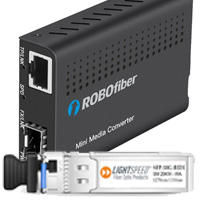As projects continually increase in size, so do cable runs. In many applications, twisted pair connections are often remotely located and require extended lengths of cable — security cameras monitor outdoor locations, outbuildings connect to local area networks, remote rooms demand streaming media and gates require network connectivity.
Twisted pair cable has a length limitation of 330 feet (100m) or less depending on device power and bandwidth. Optical based systems, on the other hand, leverage lasers to send signals 1000ft (300m) on multimode fiber and many miles on single mode fiber.
While fiber optic ports are becoming increasingly common on networked electronics, the majority of connected devices still rely on RJ45 twisted pair connections. To help bridge the copper-fiber divide, media converters and transceiver modules (also known as SFPs or mini-GBICs) are often required.
Media converters effectively convert one “media” format to a different format — i.e., copper to fiber and vice versa. They can be used in pairs, with one converter on each end of the cable run, or in conjunction with other network-based devices, such as fiber-enabled network switches.
This article explores media converters, the fiber that connects them, and other hardware commonly deployed to extend the twisted pair port on a network device over an extended distance.
Choosing a Media Converter
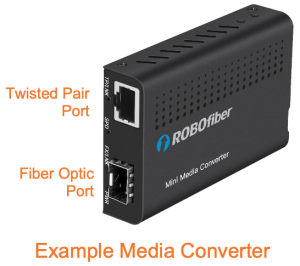
As discussed above, media converters convert signals from one format to another. In residential AV, commercial AV and security applications, this typically means converting twisted pair to fiber and vice versa, and in doing so providing the benefits of a fiber transfer standard: extended transmission distance, immunity-free cabling and higher bandwidth capacity.
Not all media converters are created equally and it’s essential to choose a model that matches the signal format and distance your application requires. For example:
- Some media converter models are very basic and simply convert a single twisted pair port to a fiber port,
- Other models feature multiple twisted pair ports and effectively act as a small network switch,
- More advanced models inject PoE to remotely power devices such as cameras and access points, and
- Some media converters tackle other signal formats such as RS232, RS485 and RS422.
Finally, media converters are designed to be an integrated part of a professional installation. Wall-mounting brackets and rack-mounted trays engineered specifically for media converters are available.
Choosing Fiber Cable and Connectors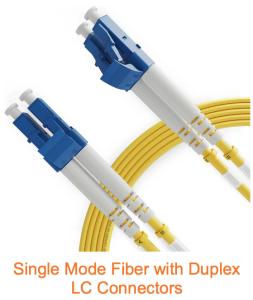
Fiber optic cable and connector type is dictated by the connections on the media converter and/or network switch. Thankfully, modern electronics are typically flexible due to swappable transceiver ports that adapt to different cable and connector types.
That said, there are some best practices when selecting interconnects:
First, integrate a cable with at least two optical strands (also known as duplex fiber). Most media converters leverage transceiver modules that feature two connections. The first connection is used to transmit data, and the second connection is used to receive data.
Second, integrate multimode mode fiber for runs under 1000ft (300m) and single mode fiber for runs over 1000ft (300m). Simply put, single mode fiber features a smaller core size that leads to lower attenuation and therefore longer transmission distances and higher bandwidths. The physics are straight forward: a smaller pipe means less signal reflection. Most integrators choose to only integrate single mode fiber because of it’s flexibility, performance and cost.
Third, integrate a cable that’s built for your environment. Fiber optic cables are available in multiple jacket and armoring constructions. When choosing a cable consider whether you’ll need a burial-grade construction, something armored for added protection, or possible a plenum or riser rating for in-wall installation.
Fourth, integrate LC connectors. While older electronics featured a myriad of different connector formats, most modern transceiver modules feature duplex (two strand) LC connections.
Finally, verify your transceiver is compatible with your electronics, cable and connectors. The recommendations above are based on common standards; however, they don’t conform to every device or application. Perhaps your best move is to standardize design and sourcing from a single trusted source.
As an example, the below Future Ready Solutions’ products are compatible and commonly used in security applications:
- Fiber-to-twisted pair media converter (ROBOfiber LFC-1001-SFP)
- 1G single mode transceiver module (LightSpeed SFP-1G-SM20K)
- Riser-rated duplex single mode bulk fiber (Cleerline D29125SMOSR)
- Single mode LC fiber optic connectors (Cleerline SSF-LC-SMUPC-10)
Future Ready Solutions also stocks additional products as required for most applications.
Media Converter to Media Converter Application
Now that we understand the basics of media converters and the cabling that connects them, let’s explore some common applications.
The most frequent application involves extending the connection between a twisted pair-based device (in this example a security camera) and a network switch as shown below. Two fiber-to-twisted pair media converters attach the devices using single mode fiber and LC connectors. The devices gain the benefits of distance, signal integrity, interference isolation and electrical immunity.
The parts list for this application includes:
- 2x fiber-to-twisted pair media converters (ROBOfiber LFC-1001-SFP)
- 2x 1G single mode transceiver modules (LightSpeed SFP-1G-SM20K)
- 1x riser-rated duplex single mode bulk fiber 1000ft spool (Cleerline D29125SMOSR)
- 1x 10-pack of single mode LC fiber optic connectors (Cleerline SSF-LC-SMUPC-10)
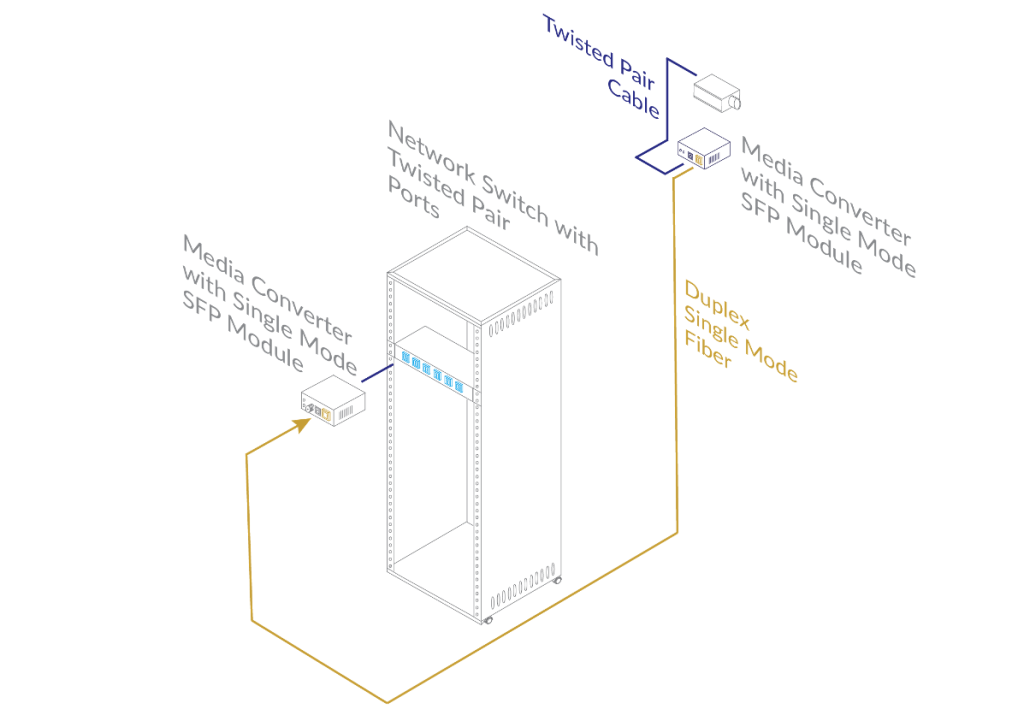
Multi-Fiber Media Converter to Media Converter Application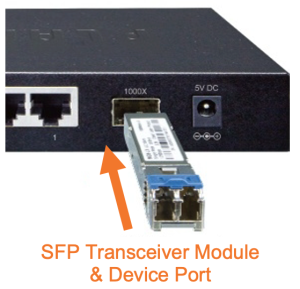
It’s not uncommon to see multiple different types of fiber in a single installation. For example, multimode fiber might be used to wire ports within the building, whereas single mode fiber is used to wire remote locations outside the building.
The good news is most media converters support both multimode and single mode fiber with a simple SFP transceiver swap.
The below application shows two fiber connections with twisted pair-based devices: an access point is connected to a network switch using multimode fiber and LC connectors, and a security camera is connected to a network switch using single mode fiber and LC connectors. The same media converters are used; however, the transceiver modules are specific to the fiber type.
Both cable runs gain the benefits of distance, signal integrity, interference isolation and electrical immunity.
The parts list for this application includes:
- 4x fiber-to-twisted pair media converters (ROBOfiber LFC-1001-SFP)
- 2x 1G single mode transceiver modules (LightSpeed SFP-1G-SM20K)
- 2x 1G multimode transceiver modules (LightSpeed SFP-1G-MM550)
- 1x riser-rated duplex multimode bulk fiber 1000ft spool (Cleerline D50125MOM3R-1000)
- 1x plenum-rated duplex single mode bulk fiber 1000ft spool (Cleerline D29125SMOSP-1000)
- 1x 10-pack of multimode LC fiber connectors (Cleerline SSF-LC-MMFPC-10)
- 1x 10-pack of single mode LC fiber connectors (Cleerline SSF-LC-SMUPC-10)
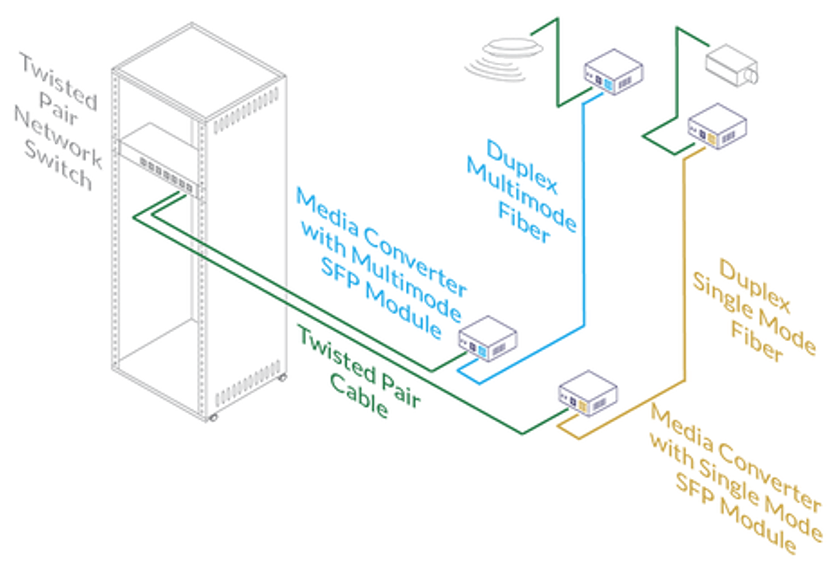
Media Converter to Network Switch Application
A third frequent application involves connecting a fiber-to-twisted pair media converter directly to a fiber port on a network switch over an extended distance as shown below.
In this application, the network switch connects to to the media converter using single mode fiber and LC connectors; however, the cable run passes through two outdoor enclosures that transition the cable from indoor riser to outdoor direct burial. Cable transitions are common in remote outdoor applications such as build-to-building connectivity and security based installations.
As with the previous applications, both the media converter and network switch use matching SFP transceiver modules, and an incoming fiber-based internet connection is present.
The parts list for this application includes:
- 1x fiber-to-twisted pair media converter (ROBOfiber LFC-1001-SFP)
- 1x fiber and twisted pair industrial network switch (ROBOfiber HGW-804SM)
- 2x 1G single mode transceiver modules (LightSpeed SFP-1G-SM20K)
- 1x riser-rated duplex single mode bulk fiber 1000ft spool (Cleerline D29125SMOSR)
- 1x direct-burial two strand single mode bulk fiber 1000ft spool (Cleerline 2ACS9125OS2PE-1000)
- 2x 10-pack of single mode LC fiber optic connectors (Cleerline SSF-LC-SMUPC-10)
- 2x outdoor hybrid LGX fiber enclosures (LightSpeed FTTX-NID-LGX)
- 2x hybrid LGX fiber panels (LightSpeed FTTX-LGX-MIXED)
- 1x FTTx outdoor demarcation enclosure (LightSpeed FTTX-NID-150)
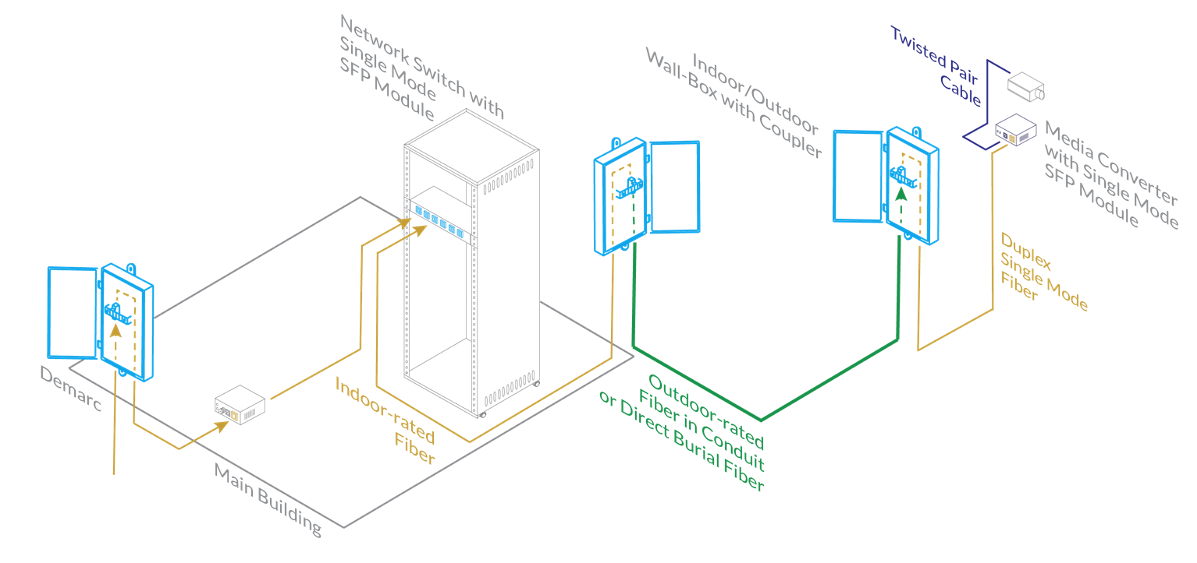
Final Notes and Product Selection
Media converters are available in a variety of formats with different capabilities. ROBOfiber, a leader in the category, offers models for 1G, 10G and even for multiple twisted pair connections. A list of products is available on the Future Ready Solutions website.
ROBOfiber also offers industrial network switches and other fiber-based signal management solutions.
No matter what product you choose, keep in mind fiber-based electronics require local power for proper operation.
Additional information on the products and applications discussed above is available from Future Ready Solutions.

